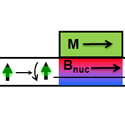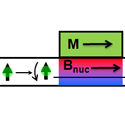Island adventure
Spintronics is a discipline that seeks to exploit the spin dimension for novel electronic applications. Typically, timed pulses of light at optical or microwave frequencies are used to control the direction of a spin or ensemble of spins; but maintaining the coherence of the spins as they are transported through a device has proven challenging.
Writing in Physical Review Letters, Mark Nowakowski and colleagues from the University of California, Santa Barbara, with collaborators at Pennsylvania State University, both in the US, demonstrate a method for controlling the direction of the spin of an ensemble of electrons as they travel through a semiconductor. The sample is a channel with an island of in the middle. Polarizing the nuclei under the island, either electrically or optically, creates a localized effective magnetic field. When an optically injected spin ensemble created at one end of the strip traverses the region, the electrons precess faster due to the effective magnetic field. The authors achieve an increase in rotation angle of the moving spins by radians over a distance of microns. By making a second sample with an electrical contact to the island, the authors also demonstrate the ability to control the nuclear field strength electrically, highlighting the versatility of their approach. – Daniel Ucko





